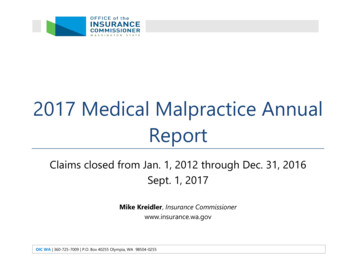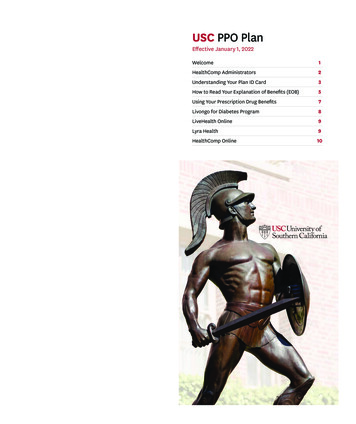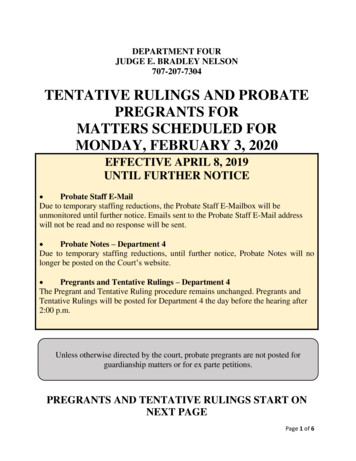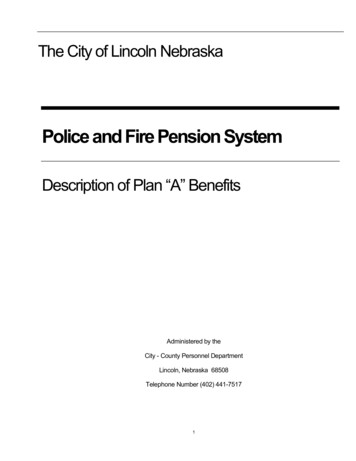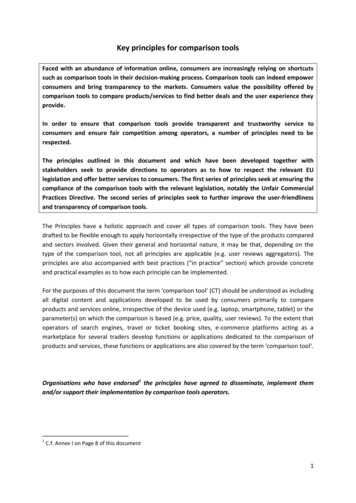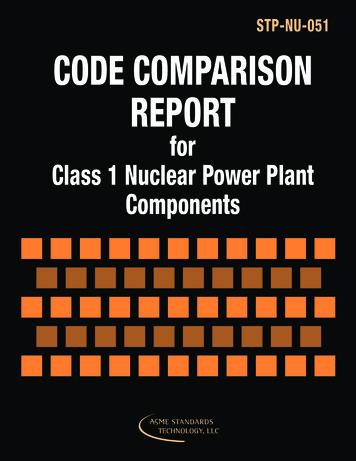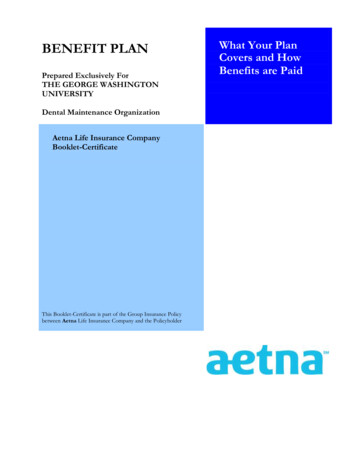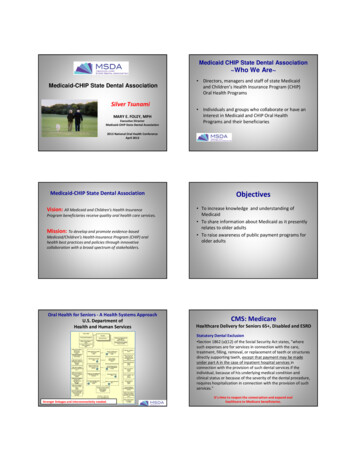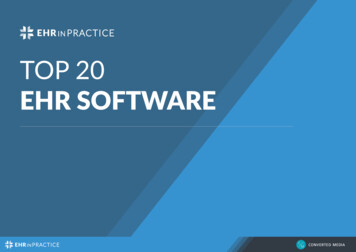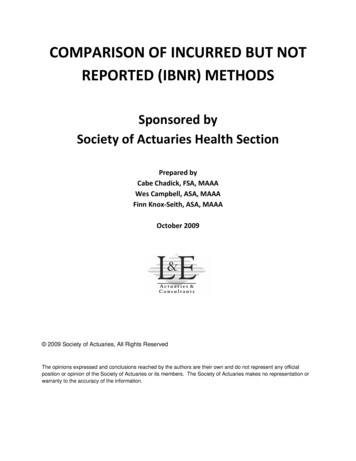
Transcription
COMPARISON OF INCURRED BUT NOTREPORTED (IBNR) METHODSSponsored bySociety of Actuaries Health SectionPrepared byCabe Chadick, FSA, MAAAWes Campbell, ASA, MAAAFinn Knox‐Seith, ASA, MAAAOctober 2009 2009 Society of Actuaries, All Rights ReservedThe opinions expressed and conclusions reached by the authors are their own and do not represent any officialposition or opinion of the Society of Actuaries or its members. The Society of Actuaries makes no representation orwarranty to the accuracy of the information.
Comparison of IBNR MethodologiesForewordLewis & Ellis, Inc. (L&E) would like to acknowledge those who participated in the development of thisresearch paper, especially the Society of Actuaries Project Oversight Group (POG), who provided adviceand guidance during the course of the project. We would also like to thank the research coordinatorsfrom the Society of Actuaries for their efforts in organizing and coordinating the project.The members of the POG were:Eric SmithbackDavid NelsonJohn GovernalePeter HowardBernie RabinowitzMartin StaehlinMichael BearsPat KinneyJohn Stenson, ChairThe project coordinators from SOA were:Steven SiegelBarbara ScottThe researchers from Lewis & Ellis, Inc. were:Cabe ChadickWes CampbellFinn Knox‐SeithBrian Stentz 2009 Society of Actuaries, All Rights ReservedLewis & EllisPage 2
Comparison of IBNR MethodologiesTable of ContentsIntroduction. 5Definitions . 10Executive Summary . 13Summary of Methods to Calculate IBNR. 16Tabular Methods. 16Case Reserve Methods. 16Projection/Exposure Methods . 17Development Methods . 18Description of Typical Development Methods . 18Cross‐Incurral Method . 18Paid PMPM Method. 19Stochastic Methods. 19Neural Network Methods . 20Practical Considerations for IBNR Issues. 21Incurred Date Definition . 21Methods Delineating ICOS versus True IBNR. 22Excess or Outlier Claims . 23Outside Influences on Health Claim Reserves and Patterns. 24Seasonality . 24Days in a Month to Generate Claim. 24Claim Cost Trends . 25Growing/Diminishing Blocks . 25Premium Changes . 26Benefit Changes . 26Claim Administration Disruption/Backlogs . 27Methods and Issues of Managed Care . 28Margin and Confidence Intervals . 28 2009 Society of Actuaries, All Rights ReservedLewis & EllisPage 3
Comparison of IBNR MethodologiesFollow‐Up Studies . 29Internal Consistency with Insurer Financials . 31Documentation and Data Quality . 31Checklist for Actuaries Calculating Claim Reserves . 32Basic Review of IBNR Methods Tested . 33Definition of Accuracy Applied for IBNR Testing Purposes . 35Data Simulation . 36Summary . 36Description of Crystal Ball Use . 37Lag Set Simulation . 37Determination of Number of Scenarios for Statistical Significance . 40Description of Stress Testing Scenarios . 41Results and Conclusions . 44Bibliography . 54AppendicesDevelopment Method Details .AAlgebraic Definitions of IBNR Methods . BDescription of Paid PMPM Method . CStochastic Method Literature, Our Tested Implementation and Stochastic Software Tools .DDetailed Results of IBNR Tests . EManaged Care Issues . FIBNR Margin .GAdvance Methods: Neural Network .HConfidence Intervals for Regressions. I 2009 Society of Actuaries, All Rights ReservedLewis & EllisPage 4
Comparison of IBNR MethodologiesIntroductionAbstractRecognizing the lack of comparative information on techniques used for estimating incurred but notreported (IBNR) reserves, the Heath Section Council of the Society of Actuaries commissioned a researchproject to assess the accuracy of commonly used IBNR estimation methods over a wide range ofscenarios. Lewis & Ellis, Inc. (L&E) was awarded the contract to perform this research.To conduct the study, a stochastic model was constructed to compare and score estimates produced by theIBNR methods that were selected for testing. The testing was done over a significant number of iterationsand alternative business situations.Findings from the model testing include the following:1. When lag methods were tested, the more robust average lag methods and hybrid methodsproduced better results than straight average methods. Hybrid methods also produced fairly lowmean errors and standard deviations2. For the methods and scenarios tested, the one exhibiting the most consistency, in terms ofrelatively lower variance and mean error, was the Paid PMPM method. The method also oftenprovided useful claim reserve estimates in recent incurral months as well as handling claimsadministration disruptions relatively better.3. Traditional lag methods exhibited the least amount of variation in mean IBNR error when testedunder an alternative business situation that entailed material shifts in per capita claims costs atvarious time points prior to the valuation date.4. The two business situations tested that were the most problematic to the desired goal of reservesufficiency were (a) very recent upward increases in claims costs and (b) rate spirals.The following comments describe limitations of the study and practical considerations when calculatingIBNR estimates, and highlight specific areas where caution should be applied when interpreting theresults:1. Advances in computing power and increasing software sophistication are making new and nontraditional methods more accessible to practicing actuaries. Yet, more sophisticated IBNRcalculation methods, while possibly more accurate, often require additional assumptions andsupporting data as well as adjustments (e.g., seasonality adjustment to Paid PMPM method) toderive reasonable results. These methods may also require advanced technical knowledge and thepurchase of specialized software as compared to those methods generally in use by practicinghealth care actuaries.2. The loss ratio method tested produced some of the more accurate results with fairly low standarddeviations, but there are several important cautions in the interpretation of these results and theappropriateness of use of this method.3. Most health care actuaries use a variety of methods to estimate IBNR, and the preferred methodmay be a combination of two or more of the tested methods (or other ones). For instance, lagmethods tend to be the most common methods used by health actuaries; however, the results 2009 Society of Actuaries, All Rights ReservedLewis & EllisPage 5
Comparison of IBNR Methodologiesconsistently indicate these methods have the highest standard deviations. Thus, the use of asecond method is suggested in order to obtain reasonable results in the more recent incurralmonths.4. Understanding a health plan’s particular facts and circumstances (current environment) may bethe most important assumption to specifically document prior to deciding on the most appropriatemethod for a specific analysis. The following four operational parameters are highlighted asparticularly difficult to characterize and predict:a. Seasonality of claim payments/processing;b. Impact of large claims on the data;c. Impact of "negative" claim amounts on lag factors and loss ratios; andd. Credibility of the underlying trend in "cost" that results from the developed IBNRestimate.Finally, it is important to note that ultimately the best method or combination of methods to use in aparticular situation may be dependent upon factors and actuarial judgment that cannot be tested through ascientific model. In this sense, the report should not be construed as recommending or endorsing a bestmethod. Rather, the report is intended to provide useful information about the advantages anddisadvantages of many commonly used methods and advance knowledge in this area for the practicinghealth care actuary. 2009 Society of Actuaries, All Rights ReservedLewis & EllisPage 6
Comparison of IBNR MethodologiesBackground and PurposeWith increased scrutiny on financial reporting and ongoing solvency concerns, health actuaries are facedwith the need, more than ever, to deliver reliable estimates of claim costs and reserves. A number ofmethods exist for calculating incurred but not reported (IBNR) reserves. However, practical techniqueshave not been substantially updated in a number of years. Further, significant changes in technology andspeed of claim payment may make new techniques more applicable. Currently, when faced with a choiceof which method may be most accurate and appropriate in a given situation, there is a dearth ofinformation to guide health actuaries. As such, the Health Section Council (HSC) of the SOA identified aneed for comparative information on the accuracy of various IBNR methods.The HSC sought proposals and awarded a contract for research that would result in a practical guide ondistinguishing between IBNR methods and to inform decision-making on the best method for a givencircumstance. The HSC was also interested in creation of a basic software tool to accompany the practicalguide. The focus of the research is on medical insurance, and, as such, the intended audience is healthpractitioners.Lewis & Ellis, Inc. (L&E) was awarded the contract to perform this research. The project objectivesspecified that L&E should test a number of methods on a data set it provided and rate the methods foraccuracy and applicability for a number of situations. The methods were supposed to include thosecommonly used by health actuaries to calculate IBNR such as the completion factor method (as well asvariations of it) and others. Statistical model methods were to be potentially considered for evaluation.But, the methods considered for comparison should also be such that a practitioner could apply themwithout the need for special hardware or software packages. In order to easily compare the methods, L&Ewas asked to either use a commonly applied measure of accuracy or develop a new measure to score theIBNR methods.ReliancesThere are many well-written and well-read pieces of actuarial literature (see bibliography) on healthliabilities and their calculation. This literature has defined terms, methods and other relevant ideas so welland predominantly among practicing actuaries that we have taken liberties to replicate these definitions,methods, etc., albeit with intended references.DisclaimerUsers of this report should possess a certain level of familiarity with actuarial techniques and health careso as not to misinterpret the data presented. Any use or distribution of this report should be made in itsentirety. In addition, any third party with access to this report acknowledges, as a condition of receipt, thatL&E does not make any representations or warranty as to the accuracy or completeness of the material.Any third party with access to these materials cannot bring suit, claim or action against L&E, under anytheory of law, related in any way to this material.The report, accompanying model and other documentation contained herein do not represent an officialposition, statement or endorsement on behalf of the Society of Actuaries or its members for a particularmethod or combination of methods for calculation of incurred but not reported reserves (IBNR), nor 2009 Society of Actuaries, All Rights ReservedLewis & EllisPage 7
Comparison of IBNR Methodologiesshould the material be construed to do so. It is the product of a research effort commissioned by theSociety of Actuaries Health Section to add to the library of resource information for the estimation ofIBNR reserves and further knowledge in that area. The material is neither intended to preclude the use ofother methodologies for estimation of IBNR reserves for any purpose nor provide an official statement orposition on the use, application or preferability of other methodologies as compared to the methodologiesdescribed herein.Defining IBNR“IBNR” is an acronym, short for “incurred but not reported,” that is probably used the most by actuariesand non-actuaries alike to refer to a certain balance sheet liability of an insurer or HMO. Anothercommon proxy for this acronym is “claim reserves,” which we will also use in this report. However,“IBNR” has a more formal definition (see below) in which it is merely one part of an insurer’s claimliabilities. For the purpose of this report we are not going to use the formal narrow definition of “IBNR.”In this report we will broadly consider “IBNR” or “claim reserves” to represent a broad collection ofinsurer or HMO balance sheet entries technically representing a more formal definition of “liabilities” butnot the formal definition of “reserves.” Whereas “liabilities” formally relate to events that have alreadyoccurred, but for which a payment has not yet been made and thus costs have already accrued, “reserves”are formally related to entries for amounts that the company has become obligated to pay, but for whichthe reimbursable event has not yet occurred, and thus these costs will accrue in the future. Our broadloose use of the acronym “IBNR” will encompass the following formal claim liability parts:1. Incurred But Not Reported Claim Liabilities—Liabilities for claims that are anticipated but havenot been reported to the health plan as of the valuation date. In this report, if we want to refer tothis narrow formal definition, we will use the phrase “true IBNR.”2. In Course of Settlement (ICOS) Claim Liabilities—Liabilities for claims reported and receivedbut not yet adjudicated and paid as of the valuation date.3. Due and Unpaid (D&U) Liabilities—Liabilities for claims that have been reported, adjudicatedand processed, but for which final payment has not been recorded as of the valuation date. Anexample is a claim that has been adjudicated but as of the valuation date is being held until thenext date on which the health plan processes claim checks.4. Outstanding Accounting Feeds—Liabilities which have been acknowledged as payments, but forwhich no check has yet been cut as of the valuation date. The most common examples arepayments agreed to be made to pharmacy benefit managers who process pharmacy claims at thepoint of sale and then bill the health plan monthly or bi-monthly for the claims. This liabilitydefinition overlaps with the D&U definition, with the distinction possibly being a system-tosystem interface or batch processing claims versus payments made directly to a third party (e.g.,claimant).5. Disputed or Resisted Claims—Liabilities for claims that are in dispute, such as those for which aknown litigation situation exists.6. Margin—Liability for a reasonable and prudent level of conservatism to cover adverse claimdeviation. Such a margin can be an explicit amount or implicitly provided for in the variousactuarial calculations. 2009 Society of Actuaries, All Rights ReservedLewis & EllisPage 8
Comparison of IBNR MethodologiesWe will also use “IBNR” instead of the phrase “unpaid claim liabilities,” which is used by the managedcare and health maintenance organization industry, as well as use “IBNR” instead of “incurred but notpaid” (IBNP), which many actuaries use as a more formal description of all claim liabilities.For the purpose of this report, “IBNR” does not include:1. Loss Adjustment Expenses (LAEs)—Liabilities for the administrative costs associated with theadjudication of unpaid claims.2. Present Value of Amounts Not Yet Due (PVANYD)—This reserve covers claims that wereincurred on or before the valuation date which have not accrued as of the valuation date.3. Active Life Reserves—Active life reserves represent the combination of contract reserves andunearned premium reserves. The term "active life" differentiates the reserve nature from reservesrelated to insureds in claims status. Unearned premium reserves are typically an asset entry andrepresents premium that has been collected and entered in the ledger, but are actually allocated toa time period after the valuation date. A contract reserve is a reserve set up when a portion of thepremium collected in the early years is meant to help pay for higher claim costs arising in lateryears.4. Premium Deficiency Reserves—A premium deficiency reserve is a reserve that is establishedwhen future premiums and current reserves are not sufficient to cover future claim payments andexpenses for the remainder of a contract period.5. Provider Liabilities—Provider liabilities represent the reporting entity’s obligation to make futurepayments to providers under some form of risk-sharing arrangement.6. Provider Insolvency Reserves—Additional liabilities that may arise if a capitated providerbecomes insolvent. 2009 Society of Actuaries, All Rights ReservedLewis & EllisPage 9
Comparison of IBNR MethodologiesDefinitionsWe consider the following to be common definitions for phrases used in conjunction with health claimreserves and IBNR.Active Life Reserves 1 : The combination of contract reserves and unearned premium reserves. The term“active life” differentiates these reserves from reserves related to contracts in claims status or for“disabled lives.”Age-to-Age Development Factors: Factors to complete paid claims to date in which the factors are basedon the product of multiple representative ratios (i.e., the respective lag month for which the factor isgenerated through lag month of full completion) of one lag month’s cumulative paid claims to the priorlag month’s cumulative paid claims.Age-to-Ultimate Development Factors: Factors to complete paid claims to date in which the factors arebased on the ratio of the lag month’s cumulative paid claims to the fully complete ultimate claims.Claims Adjudication 2 : The process by which the insurer’s claim processing area determines that aninsured is eligible for payment and establishes an amount payable in relationship to the contractualbenefits.Claims Liability 3 : A claims liability is established when an event has occurred that creates an obligationto pay benefits, but complete payment has not yet been made as of the valuation date.Contract Reserves 4 : A contract reserve is established when some portion of the premium collected in acontract’s early durations is intentionally designed to help pay for anticipated higher claims costs in laterdurations.Claims Due and Unpaid: A reserve for claims which have been approved, but for which payment checkshave not been sent.Exposure: Unit of insured lives or premiums that contributed to exposure to a risk of a claim.Excess/Shock Claim: Larger amount claims that have on average longer lag and may cause significantchanges in total IBNR.1Lloyd, John C., “Health Reserves,” 3-5.Lloyd, “Health Reserves,” 3-5.3Lloyd, “Health Reserves,” 3-5.4Lloyd, “Health Reserves,” 3-5.2 2009 Society of Actuaries, All Rights ReservedLewis & EllisPage 10
Comparison of IBNR MethodologiesIncurred Date 5 : The date on which an obligation to pay was established relative to a claim. For medicalcoverages, this is the date on which services were rendered by a provider or the initial date of service for asequence of events which together constitute a claim.In Course of Settlement (ICOS): The reserve amount attributed to claims already known and identified bythe insurer but not yet adjudicated, settled and paid by the insurer. This reserve amount contrasts withclaim liabilities which have not yet been identified by the insurer (a.k.a. “true” IBNR). Also can bedescribed as reserves for claims that are on file in the company at the time the valuation is done, but havenot yet been approved or paid.IBNP 6 : The incurred but not paid (IBNP) liability reserve amount. Sometimes used formally in lieu of themore informal acronym “IBNR,” IBNP is another name, or acronym, for an insurer’s total claim reserve.IBNP is the sum total of all claim reserve parts (e.g., ICOS, true IBNR, etc.).Lag 7 : The time between the incurred date of a claim and the date on which a claim payment is made. Thistime can be broken into two parts: (i) the time between the incurred date and the date upon which it isreceived for consideration by the insurer and (ii) the time between the insurer’s initial consideration dateand the claim payment date.Loss Adjustment Expense 8 : The liability associated with the expense of processing claims that will bepaid after the valuation date.Present Value of Amounts Not Yet Due (PVANYD): Also called "disabled life reserves" in the case ofinsurance providing ongoing periodic benefits past the reserve valuation date because of a benefit triggerthat occurred on or before the valuation date (e.g., monthly loss-of-time benefits for disability due toaccident or sickness, monthly reimbursements or payments for long-term care expenses, etc.). Thecommon statutory definition is: “the reserve for claims unaccrued which may at the option of the insurerbe discounted at interest.” This reserve is rarely considered part of the health IBNR.PMPM: Per member per month, which is a statistic measure of the average monthly per capita incurredclaims where the per capita basis is membership (e.g., number of insureds, including primary insureds,spouses and children).Resisted Claims Reserve: Reserves for those claims in dispute and/or where the obligation to pay suchclaim is not reasonably clear as of the statement date.Seasonality 9 : Tendency for the amount of incurred claim liabilities to vary in a consistent and predictablemanner within the space of a calendar year. In health insurance, seasonality may be due to seasonalvariations in morbidity (the rate at which individuals seek medical care), benefit design (such as when a5Lloyd, John C., “Health Reserves,” 3-5.Lynch, Robert, “Method for Calculating IBNP Health Reserves with Low Variance,” 7.7Lloyd, “Health Reserves,” 4.8Lloyd, “Health Reserves,” 3-5.9Lynch, Robert G., Patent description “Method for Calculating IBNP Health Reserves with Low Variance,” Oct. 6,2005.6 2009 Society of Actuaries, All Rights ReservedLewis & EllisPage 11
Comparison of IBNR Methodologieshealth plan has an annual deductible or annual out-of-pocket cost-sharing maximum), or calendar effects(for example, variation in monthly claims caused by the differing number of days in each month, ordifferences in the number of working days in a month.)Valuation Date 10 : The date upon which an insurer’s financial reports are compiled by closing the insurer’sgeneral ledger, creating a set of cash accounting entries, and creating reserve estimates. Typical valuationdates are year-end, quarter-end or sometimes every month’s end.10Lloyd, John C., “Health Reserves,” 4. 2009 Society of Actuaries, All Rights ReservedLewis & EllisPage 12
Comparison of IBNR MethodologiesExecutive SummaryThe purpose of this section is to summarize the results of our testing and analysis of IBNR calculationmethods. Later sections of the report explain the methods themselves.With the wide variety of policy types, adjudication practices, lag times and other variables, it isimpossible to say that a given method is the perfect method in all cases. Even in our testing, differentmethods for a particular block performed better under different scenario tests. We have, however,analyzed our results in an effort to provide some basic guidelines to help you determine the best methodfor your particular circumstances. We have based our conclusions on only a subset of the scenario teststhat we created and tested. We have chosen to omit the rate shift, claim shift and disruption scenarios dueto extreme variance of the results. We have assumed that, in situations like this, the actuary would beforced to make manual adjustments in some way, and could never simply run an IBNR calculation withthe data as-is. As a result, we have focused on those scenarios that are more typical and that can, for themost part, be handled without any adjustments.1. Lag methods tend to be the most common methods used by health actuaries; however, our resultsconsistently show them to have the highest standard deviation. Even the more advanced lagmethods, while their performance is definitely better than the simple methods, still generate alarge standard deviation. Another problem with lag methods is that they require a significantamount of claims completion for a given month before they begin to develop any sort ofaccuracy. This can be seen in our results by simply looking at the mean error for the HMOMedicare block versus the Medicare Supplement block. For a block that completes fairly quicklylike the HMO Medicare block, the mean error is in the low single digits. However, for theMedicare Supplement block, the mean error is around 28 percent. Thus, the use of a secondmethod is required in order to achieve accurate results in the more recent incurral months. OurHybrid Loss Ratio
But, the methods considered for comparison should also be such that a practitioner could apply them without the need for special hardware or software packages. In order to easily compare the methods, L&E was asked to either use a commonly applied measure of accuracy or develop a new measure to score the IBNR methods. Reliances


